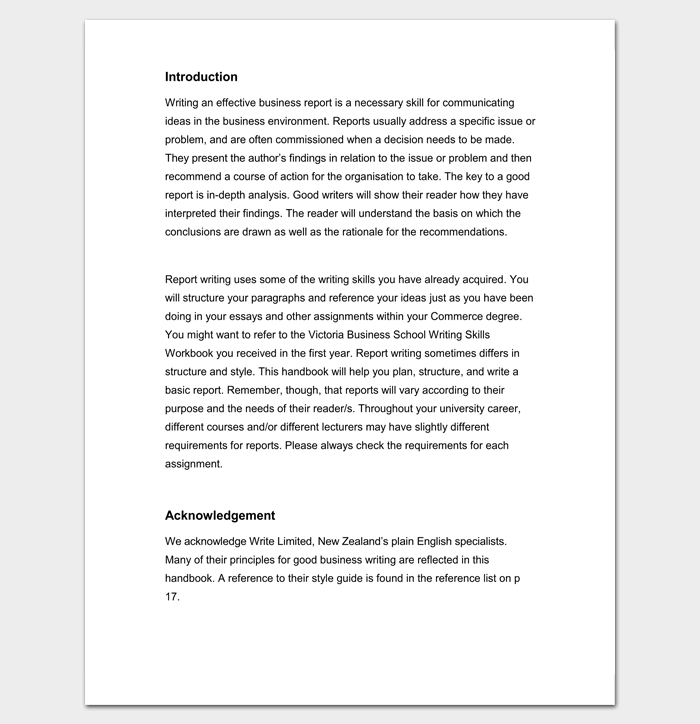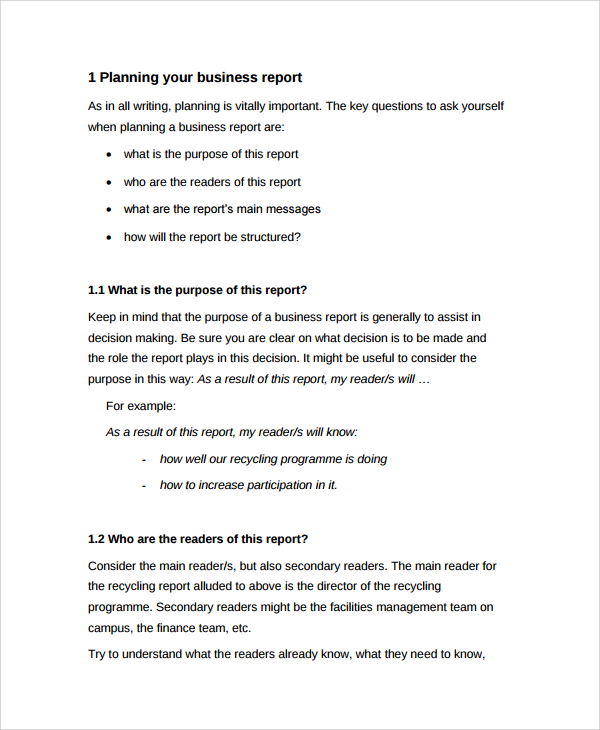
May 28, · Before you start writing, set aside some time to choose a great topic that will engage your audience. Next, support your topic with research that comes from credible sources. Once you’ve chosen a report structure that will convey your information in an efficient and effective way, you’re ready to draft your ideas into an outline REPORT WRITING The Principle Differences Between Report & Essay Writing • The principles for researching, drafting, editing and rewriting a report are the same as those described above for essay writing. 1) Understanding the Essay / Assignment Title: 2) Initial Plan, Identifying and Gathering Information 3) Organise information Writing a Book Report Book reports can take on many different forms. Three types of effective book reports are plot summaries, character analyses, and theme blogger.comg a book report helps you practice giving your opinion about different aspects of a book, such as an author's use of
Easy Ways to Start Writing a Report (with Pictures) - wikiHow
Last Updated: May 28, References, outline for report writing. This article was co-authored by our trained team of editors and researchers who validated it for accuracy and comprehensiveness.
wikiHow's Content Management Team carefully monitors the work from our editorial staff to ensure that each article is backed by trusted research and meets our high quality standards. There are 14 references cited in this article, which can be found at the bottom of the page.
This article has been viewed 10, times. Learn more Reports are a useful way to relay information back to an outline for report writing. However, since this type of writing is so broad, it can be difficult to know how to begin. Before you start writing, set aside some time to choose a great topic that will engage outline for report writing audience.
Next, support your topic with research that comes from credible sources, outline for report writing. Tip: Keep in mind that not all reports will necessarily be assigned. In the event of a car accident or random crime, you might have to report to your insurance company or fill out a police report.
For these documents, try to approximate the likely audience of your report, like an officer or insurance agent. Tip: Try to look for academic sources that are peer-reviewed.
Log in Social login does not work in incognito and private browsers. Please log in with your username or email to continue. wikiHow Account. No account yet? Create an account. Community Dashboard Write an Article Request a New Article More Ideas Edit this Article.
Courses New Skills for Work New Expert Videos About wikiHow Pro Upgrade Sign In. Home Random Browse Articles Courses New About wikiHow Easy Ways to Help Approve Questions Fix Spelling Quiz App More Things to Try We use cookies to make wikiHow great.
By using our site, you agree to our cookie policy. Cookie Settings. wikiHow is where trusted research and expert knowledge come together. Learn why people trust wikiHow. Categories Education and Communications Writing Official Writing Report Writing How to Start Writing a Report.
Download Article Explore this Article parts. Tips and Warnings, outline for report writing. Related Articles. Co-authored by wikiHow Staff Last Updated: May 28, References. Part 1. All rights reserved. wikiHow, Inc. is the copyright holder of this image under U. and international copyright laws.
This image may not be used by other entities without the express written consent of wikiHow, Inc, outline for report writing. Go over your assignment until you understand it. Read over the document, email, or message that describes the parameters of the report. Is only one person going to read it, outline for report writing, like a professor or boss? Is it something that will be published on a wider level? Try to determine this until you fully understand what needs to be included in the report.
Brainstorm the most effective points and arguments to include. Think about what the reader expects to get out of this report. Are they expecting a detailed analysis of a topic, or a brief overview of certain events? In a report outline for report writing those events, you only want to go over the highlights—not each and every detail of the project.
Outline different ideas before deciding on one that you like. Outline for report writing up a new digital document or set aside a sheet of paper to begin planning the content of your report. Depending on the assignment, you might have some difficulty narrowing down an exact topic or focus for your final deliverable. In this case, start with one idea that you have and expand upon it an outline.
Choose a topic that is easy to research, outline for report writing. In the event that you get the freedom to choose your exact topic, outline for report writing, look into ideas that will be enjoyable and engaging to research. Search online or go to your local library to look up content that appeals to you, and see if you could expand upon any of those topics into your report.
Part 2. Use databases to find credible content. Search online to find free databases, which will lead you toward scholarly texts and journal articles. If you attend a university, ask a librarian to see if your school is subscribed to any paid databases. Go to your local library to look for helpful material.
Use general keywords when searching for materials—you might accidentally be skipping over great sources by being too specific. If you need any help, call your library for assistance.
While there are many credible nonprofit groups out there, check to make sure that the website is founded in facts and credibility. Duplicate your findings in another source. Continue searching in both print and online sources for an original piece of information. If you discovered your findings on your own, repeat the process until start to see patterns in the data you collect.
Look for a sleek format with balanced colors, as well as a professional font. Part 3. Break your information into clear groupings: introduction, body, and conclusion. Although different reports will require different kinds of sections, make sure that you have a clear section introducing the content, as well as a section that wraps up the information.
Short memos, letter reports, and informal lab reports all fall under this category. For example, a short memo or letter report includes a heading, introductory statement, outline for report writing, and recommendation section.
In-depth reports can generally be divided into 5 major sections: preliminaries, abstract, body, references, and attachments. When drafting this document, make sure that you include plenty of room for data results, like graphs.
A self-evaluation at a university is a good example of this. When inspecting a building or other structure, make your findings as clear as possible by using a consistent, predetermined document.
If there are no documents lying around, keep your report simple, concise, and understandable to whoever might be reading it.
Use a progress report to display how a group or corporation has done while going from point A to point B. While graphs and other visuals outline for report writing very helpful in these reports, be sure to follow the structure and outline that you establish at the beginning of the document. Part 4. Explain your main purpose of the report in the thesis. Figure out the main point, or thesis, of your document and write in the first section of the outline. If you prefer to work sequentially, try creating an outline with Roman numerals and letters.
Try to list the information in the same order that you want it to appear in the final draft of the document. Include any supporting details as you think of them. Create sub points in the outline that involve extra evidence or sourcing for your ideas.
Figure out your introduction and conclusion at the end. Once you have a better picture of how you plan on formatting your report, write out a sentence or 2 on how you plan on introducing and wrapping up a variety of topics. Start fleshing your outline into outline for report writing full report. Go section by section as you begin drafting your report. Build your first paragraph around this main purpose, and guide the reader through the main themes of the report.
Continue this process, going through your outline and transferring the body and conclusion points into a draft. If it helps, work through your report outline chronologically. Include your email address to get a message when this question is answered. Helpful outline for report writing Not Helpful 0. Submit a Tip All tip submissions are carefully reviewed before being published. Related wikiHows How to. How to, outline for report writing. More References
Creating an Outline for an Essay or Research Paper in MS Word
, time: 11:48The Writing Center | Outlining | Guides

Note: the outline might help inform the thesis, and therefore your thesis might change or develop within the outlining process. Organize your outline in whatever format fits into the structure needed for the type of paper you are writing. One common outline format uses Roman numerals, letters, and numbers May 28, · Before you start writing, set aside some time to choose a great topic that will engage your audience. Next, support your topic with research that comes from credible sources. Once you’ve chosen a report structure that will convey your information in an efficient and effective way, you’re ready to draft your ideas into an outline For creative writing, an outline may help organize the various plot threads and help keep track of character traits. Many people find that organizing an oral report or presentation in outline form helps them speak more effectively in front of a crowd. Below are the primary reasons for creating an outline. Aids in the process of writing
No comments:
Post a Comment